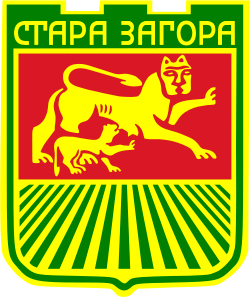Stara Zagora
| Stara Zagora Стара Загора | |||
|---|---|---|---|
| |||
| Nickname(s): The city of the linden-trees | |||
 Stara Zagora Location of Stara Zagora | |||
| Coordinates: 42°26′N 25°39′E / 42.433°N 25.650°ECoordinates: 42°26′N 25°39′E / 42.433°N 25.650°E | |||
| Country | Bulgaria | ||
| Province | Stara Zagora | ||
| Established | 342 BC | ||
| Elevation | 196 m (643 ft) | ||
| Population (2015)[1] | |||
| • City | 158,563 | ||
| • Urban | 136,807 | ||
| Demonym(s) | Zagorker | ||
| Time zone | UTC+2 (EET) | ||
| • Summer (DST) | UTC+3 (EEST) | ||
| Postal Code | 6000 | ||
| Area code(s) | 042 | ||
| Website | www.starazagora.bg | ||
Stara Zagora (Bulgarian: Стара Загора, pronounced [ˈstarɐ ˈzaɡorɐ]) is the sixth-largest city in Bulgaria,[2] and the administrative capital of the homonymous Stara Zagora Province.
It has a proud history illustrated by the many impressive ancient Roman buildings preserved in its centre.
Name
The name comes from the Slavic root star ("old") and the name of the medieval region of Zagore ("beyond the [Balkan] mountains" in Slavic)[3]
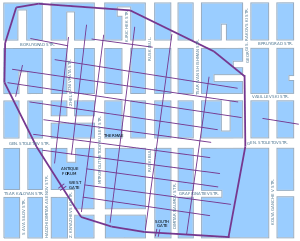
The original name was Beroe, which was changed to Ulpia Augusta Traiana by the Romans. From the 6th century the city was called Vereja and, from 784, Irenopolis in honour of the Byzantine empress Irene of Athens. In the Middle Ages it was called Boruj by the Bulgarians and later, Železnik. The Turks called it Eski Hisar (old fort) and Eski Zagra, from which its current name derives, assigned in 1871.
History
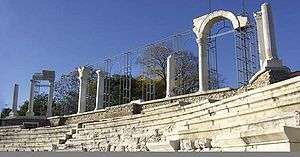
The original Thracian settlement dates from the 5-4th century BC when it was called Beroe or Beroia.
The city was founded by Phillip II of Macedon in 342 BC.[4][5][6][7]
Under the Roman Empire, the town was renamed Ulpia Augusta Traiana in honour of emperor Trajan. The city grew to its largest extent under Marcus Aurelius (161-180) and became the second most important city in the Roman province of Thrace after Philippopolis (Trimontium). Its status and importance is evidenced by the visits of several emperors including Septimius Severus (193-211), Caracalla (211-217), and Diocletian (294-305).
The Battle of Beroe was fought near the city in 250 resulting in a Gothic Victory.[8] It was probably after this event that the city walls were doubled like other cities in the region (e.g. Diocletianopolis, Serdica).
In the 2nd-3rd century the city had its own coin mint showing its importance.
In 377, in the Gothic War (376–382), the Goths marched on Beroe to attack the Roman general Frigiderus but his scouts detected the invaders and he promptly withdrew to Illyria.[9] The city was destroyed but rebuilt by Justinian.[10]
John's Byzantine army, and many of the captives, were settled as foederati within the Byzantine frontier.
In 1208 the Bulgarians defeated the Latin Empire in the battle of Boruy, also fought nearby.
The Ottomans conquered Stara Zagora in 1371. A grade school was built in 1840 and the town's name was changed to Zheleznik (Железник; a Slavic translation of Beroe) in 1854 instead of the Turkish Eskizağra (Also called Zağra-i Atik), but was renamed once again to Stara Zagora in 1870. It was an administrative centre in Edirne Province before 1878 as "Zağra-i Atik".[11] After the Liberation of Bulgaria from Ottoman rule in 1878, it became part of autonomous Eastern Rumelia as a department centre before the two Bulgarian states finally merged in 1886 as a result of the Unification of Bulgaria.
Ancient Monuments

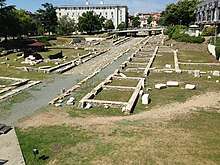

Many of the monuments from the Roman city have been excavated and are visible in situ today and include:[12]
- City walls
- The "Antique" Forum
- Roman city streets and buildings
- The Roman Baths
- 4th-6th c. public building with mosaics
- 4th c. private house with mosaics of Silenus with Bacchantes and of Dionysus’s Procession[13]
- South city gate
- Thracian Tomb
Overlooking the "antique" forum is an unusual building in the form of a monumental auditorium in the shape of a theatre.
Geography and climate
Stara Zagora is the administrative centre of its municipality and the Stara Zagora Province. It is about 231 kilometres (144 mi) from Sofia, near the Bedechka river in the historic region of Thrace.
The city is in an area of a transitional continental climate with a considerable subtropical influence. The average yearly temperature is about 13 °C (55 °F).
| Climate data for Stara Zagora (2002-2014) | |||||||||||||
|---|---|---|---|---|---|---|---|---|---|---|---|---|---|
| Month | Jan | Feb | Mar | Apr | May | Jun | Jul | Aug | Sep | Oct | Nov | Dec | Year |
| Average high °C (°F) | 6.5 (43.7) |
8.7 (47.7) |
14.1 (57.4) |
18.6 (65.5) |
24.5 (76.1) |
28.0 (82.4) |
31.5 (88.7) |
31.2 (88.2) |
26.7 (80.1) |
20.5 (68.9) |
13.8 (56.8) |
7.8 (46) |
19.3 (66.7) |
| Daily mean °C (°F) | 2.0 (35.6) |
3.5 (38.3) |
8.0 (46.4) |
13.4 (56.1) |
18.7 (65.7) |
23.0 (73.4) |
25.2 (77.4) |
25.0 (77) |
21.0 (69.8) |
15.3 (59.5) |
9.5 (49.1) |
3.9 (39) |
13.0 (55.4) |
| Average low °C (°F) | −1.5 (29.3) |
−0.8 (30.6) |
3.1 (37.6) |
8.2 (46.8) |
13.0 (55.4) |
17.1 (62.8) |
18.9 (66) |
18.8 (65.8) |
14.5 (58.1) |
10.2 (50.4) |
5.8 (42.4) |
1.0 (33.8) |
9.0 (48.2) |
| Average precipitation mm (inches) | 47 (1.85) |
35 (1.38) |
37 (1.46) |
51 (2.01) |
71 (2.8) |
66 (2.6) |
57 (2.24) |
48 (1.89) |
32 (1.26) |
45 (1.77) |
57 (2.24) |
52 (2.05) |
598 (23.55) |
| Source: [Stringmeteo.com] | |||||||||||||
Population
Stara Zagora was possibly the biggest town in today's Bulgarian territory before liberation from Ottoman rule. But the town was burned and destroyed by Turkish army during the Liberation war in 1877-1878. During the first decade after the liberation of Bulgaria, in the 1880s the population of Stara Zagora decreased and numbered about 16,000.[14] Since then it started growing decade by decade, mostly because of the migrants from the rural areas and the surrounding smaller towns, reaching its peak in the period 1989-1991 exceeding 160,000.[15] After this time, the population has started decreasing because of the low birth rate. Stara Zagora is one of the richest cities in Bulgaria with much better economic situation than average for the Bulgarian provinces.

| Stara Zagora | |||||||||||||||
|---|---|---|---|---|---|---|---|---|---|---|---|---|---|---|---|
| Year | 1887 | 1910 | 1934 | 1946 | 1956 | 1965 | 1975 | 1985 | 1992 | 2001 | 2005 | 2009 | 2011 | 2013 | |
| Population | 16,039 | 22,003 | 29,825 | 38,325 | 55,094 | 88,857 | 122,454 | 151,163 | 150,451 | 143,420 | 141,597 | 140,710 | 138,272 | 137,834 | |
| Highest number 151,272 in 1985 | |||||||||||||||
| Sources: National Statistical Institute,[15][16][17] citypopulation.de,[18] pop-stat.mashke.org,[19] Bulgarian Academy of Sciences[14] | |||||||||||||||
Ethnic linguistic and religious composition
According to the latest 2011 census data, individuals who declared their ethnic identity were distributed as follows:[20][21]
- Bulgarians: 117,963 (93.2%)
- Gypsies: 5,430 (4.3%)
- Turks: 1,965 (1.6%)
- Others: 579 (0.5%)
- Indefinable: 617 (0.5%)
- Undeclared: 11,718 (8.5%)
Total: 138,272
Sports
PFC Beroe Stara Zagora is a football (soccer) club in Stara Zagora. It was established in 1916 and plays at Beroe stadium. The team is a member of the "A grupa" league. Beroe has won the Bulgarian Cup two times (2009-2010 and 2012-2013).[22][23]
Main sights
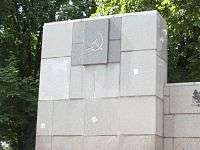
- Historical sites
- Regional Historical Museum
- The Antique Forum
- Thracian Tomb
- The Roman Baths
- Roman mosaics of “Silenus with Bacchantes" (4th century) and of Dionysus’s Procession
- The Samarsko Zname Monument
- Ayazmoto Park
- Defenders of Stara Zagora Memorial Complex
- Memorial House of Geo Milev
- The South Gate of Augusta Trajana
- The Opera House, built in 1925
- Stara Zagora Transmitter with one of the few Blaw-Knox Towers in Europe
- Neolithic Dwellings Museum[24]
Districts
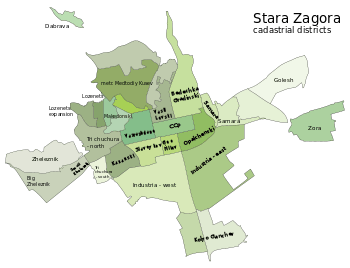
- Bedechka - Gradinski (Бедечка - Градински, named at river Bedechka)
- Central City Part (includes Supercenter, Chayka & Zagorka) (Централна градска част (Суперцентър, Чайка и Загорка) - Chayka - Sea-gull, Zagorka - named after Zagorka brewery)
- Makedonski (Македонски - Macedonian) know also as Chumleka (Чумлека)
- Dabrava (Дъбрава - former village of Dabrava)
- Eastern Industrial Zone (Източна индустриална зона)
- Geo Milev (Гео Милев - named after the Bulgarian poet)
- Golesh (Голеш)
- Industrial Zone (Индустриална Зона)
- Kazanski (Казански)
- Kolyo Ganchev (Кольо Ганчев - named after the famous Bulgarian revolutionary)
- Lozenets (Лозенец - from лозе - vineyard)
- Mitropolit Metodiy Kusev (Митрополит Методий Кусев - named after a famous Starozagorian bishop)
- Opalchenski (Опълченски - Volunteer's district named after Bulgarian voluntary army units) also known as Chaika (Чайка - Sea-Gull)
- Samara 1, 2 & 3- (Самара 1, 2 и 3 - named after the sister city of Samara, Russia)
- Slaveykov (Славейков - named after the famous Bulgarian poet Petko Slaveykov)
- Studentski grad - (Студентски град - Student town)
- Tri Chuchura north, center & south - (Три чучура север, център и юг - "Three spouts")
- Vasil Levski - (Васил Левски - named after the famous Bulgarian revolutionary)
- Vazrazhdane - (Възраждане - Renaissance)
- Zheleznik (small & big) (Железник - like one of the former names of the city)
- Zora (Зора - Dawn)
Future districts :
- Atyuren (Атюрен - future district of the city)
- Bogomilovo (Богомилово - village of Bogomilovo)
- Hrishteni (Хрищени - village of Hrishteni)
- Malka Vereya (Малка Верея - Vereya - old name of the city, Malka - small, village of Malka Vereya)
Notable people
- Anna Tomowa-Sintow, dramatic soprano opera singer
- Vesselina Kasarova, coloratura mezzo-soprano opera singer
- Vesselin Stoykov, bass-bariton opera singer[25]
- Stefan Kisyov, writer
- Stefan Slivkov, revolutionary, mayor of Stara Zagora (1885–1886) and Bulgarian National Assemblyman
Other
- Beroe Hill on Livingston Island, West Antarctica is named after this city, in its previous incarnation as Beroe.
- One of the two lighting factories Svetlina is situated here.
Twin towns and sister cities
Stara Zagora is twinned with:
Stara Zagora official day
Every year October 5 is celebrated as the official day of Stara Zagora with multiple events, concerts, activities for kids and a fair.
See also
References
- ↑ "Population by districts, municipalities, place of residence and sex". NSI. 2015-12-31. Retrieved 2016-05-13.
- ↑ (page 39) Archived September 30, 2011, at the Wayback Machine.
- ↑ "Стара Загора" (in Bulgarian). Верея Тур. Retrieved 2008-09-14.
- ↑ Women and slaves in Greco-Roman culture: differential equations by Sandra Rae Joshel, Sheila Murnaghan,1998,page 214,"Philip II founded cities at Beroe, Kabyle, and Philippopolis in 342/1, and Aegean-style urban life began to penetrate Thrace."
- ↑ Late Roman villas in the Danube-Balkan region by Lynda Mulvin,2002,page 19,"Other roads went through Beroe (founded by Philip II of Macedon) "
- ↑ Philip of Macedon by Louïza D. Loukopoulou,1980,page 98,"Upriver in the valley between the Rhodope and Haimos Philip founded Beroe (Stara Zagora) and Philippolis (Plovdiv)."
- ↑ The cities in Thrace and Dacia in late antiquity: (studies and materials) by Velizar Iv Velkov,1977,page 128,"Founded by Philipp 11 on the site of an old Thracian settlement, it has existed without interruption from that time."
- ↑ The History of Zonaras: From Alexander Severus to the Death of Theodosius, Thomas Banchich, Eugene Lane, ISBN 1134424736, 9781134424733 p 94
- ↑ Coombs-Hoar, Adrian (2015). Eagles in the Dust: The Roman Defeat at Adrianopolis AD 378. Pen and Sword. p 62-3
- ↑ http://www.livius.org/articles/place/augusta-traiana-stara-zagora/
- ↑ http://acikarsiv.ankara.edu.tr/fulltext/3066.pdf%5Bpermanent+dead+link%5D
- ↑ Historical sites: https://web.archive.org/web/20110724082217/http://museum.starazagora.net/English/brunches/Ebrunches.html
- ↑ http://archaeologyinbulgaria.com/2015/08/27/bulgarias-stara-zagora-unveils-restored-ancient-mosaics-from-roman-city-augusta-traiana-showing-silenus-with-bacchantes/
- 1 2 (in Bulgarian) Bulgarian Academy of Sciences Archived 2011-07-06 at the Wayback Machine.
- 1 2 (in Bulgarian)
- ↑ "Таблици на населението по настоящ и по постоянен адрес". ГД ГРАО. Retrieved 2016-05-13.
- ↑ (in English) Bulgarian National Statistical Institute - 2014
- ↑ (in English) „WorldCityPopulation“
- ↑ "„pop-stat.mashke.org"".
- ↑ (in Bulgarian) Population on 01.02.2011 by provinces, municipalities, settlements and age; National Statistical Institute
- ↑ Population by province, municipality, settlement and ethnic identification, by 01.02.2011; Bulgarian National Statistical Institute (in Bulgarian)
- ↑ Website: /beroe.eu
- ↑ "Loading". www.tararadam.com.
- ↑ "Neolithic Dwellings". Archived from the original on 2011-07-24.
- ↑ "Vesselin Stoykov - Offiziele Webseite » Home". www.vesselin-stoykov.com.
- ↑ "Radom - Miasta partnerskie" [Radom - Partnership cities]. Miasto Radom [City of Radom] (in Polish). Archived from the original on 2013-04-03. Retrieved 2013-08-07.
- ↑ "Radom - miasta partnerskie" (in Polish). radom.naszestrony.pl. Archived from the original on 2007-07-26. Retrieved 2013-08-07.
External links
| Wikimedia Commons has media related to Stara Zagora. |
- Stara Zagora Regional museum of history
- Stara Zagora Tourist Information Centre
- Stara Zagora Economic Development Agency
- Maps, Population, Info & Facts about cities and villages in Stara Zagora municipality
- Programata Stara Zagora — the free cultural guide of Stara Zagora
- Information and links about Stara Zagora
- Information from Visit Bulgaria
- Chamber of commerce
- Real Photos from Stara Zagora
- News and videos from Stara Zagora
.svg.png)
